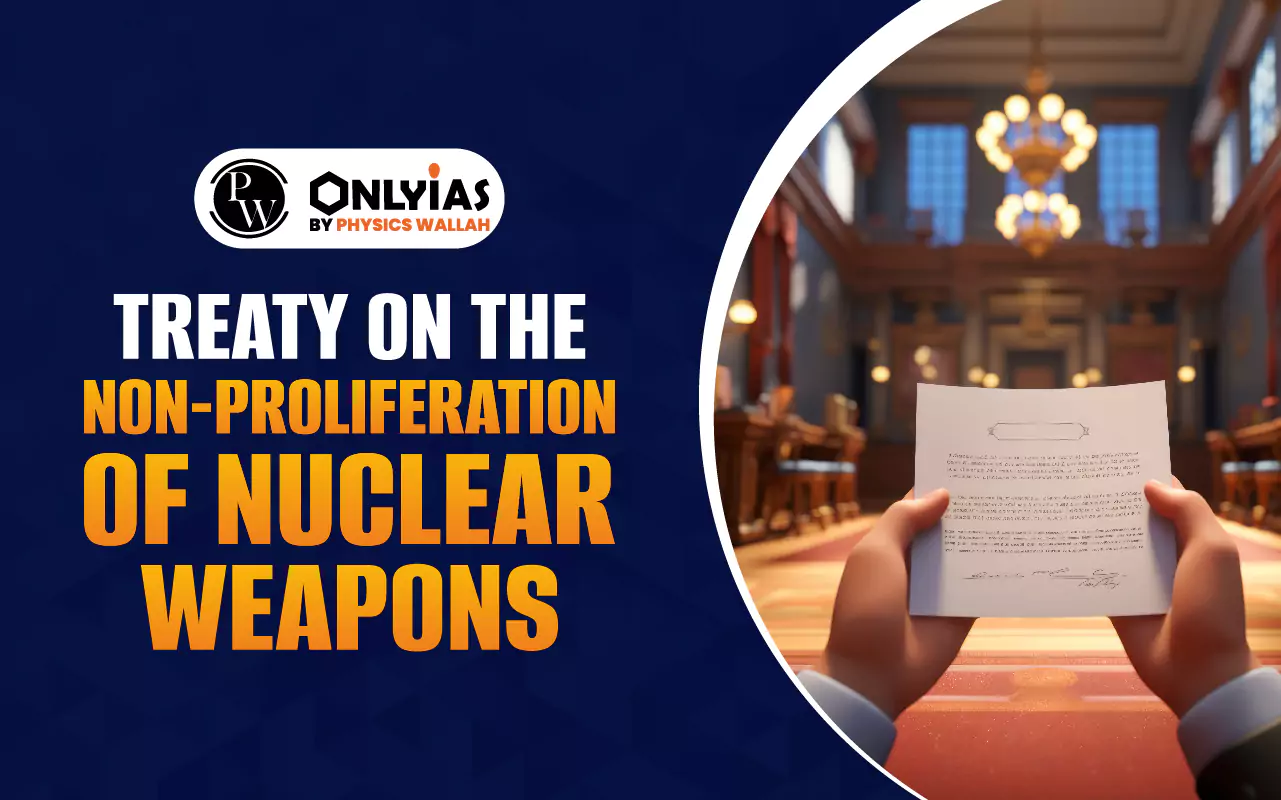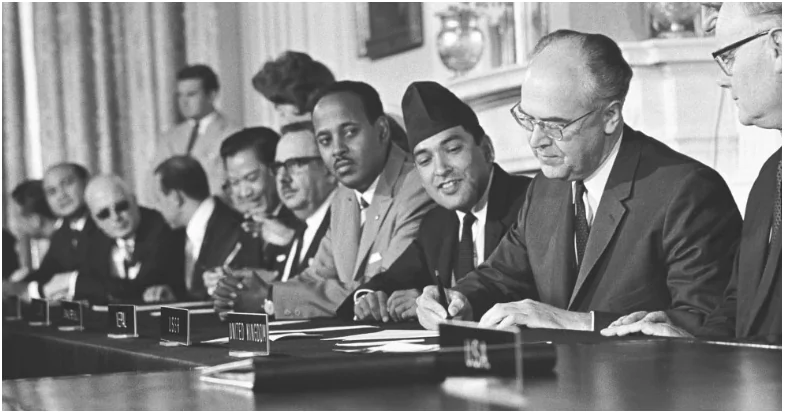Explore the Treaty on the Non-Proliferation of Nuclear Weapons (NPT), its full form, key objectives, member countries, and non-signatories. Learn about its pillars—non-proliferation, disarmament, and peaceful nuclear use—plus IAEA's role.

Treaty on the Non-Proliferation of Nuclear Weapons stands as a cornerstone of global efforts to prevent the spread of nuclear weapons, facilitate peaceful nuclear cooperation, and pursue comprehensive disarmament. Adopted on 12 June 1968 and entered into force on 5 March 1970, the NPT is recognized as the most widely adhered-to arms control agreement in history, with 191 Treaty on the Non-Proliferation of Nuclear Weapons members, including the five recognized nuclear-weapon states (United States, United Kingdom, France, Russia, and China).
The Treaty on the Non-Proliferation of Nuclear Weapons, 1968 (commonly referred to as the NPT) constitutes a three-pillar framework:

Source: icanw.org
The Treaty on the Non-Proliferation of Nuclear Weapons PDF contains detailed provisions governing these principles and outlines verification mechanisms overseen by the International Atomic Energy Agency (IAEA).
| Nuclear Non-Proliferation Treaty Overview | |
| Parameter | Details |
| NPT Full Form | Treaty on the Non-Proliferation of Nuclear Weapons (NPT) |
| Adopted On | 12 June 1968 |
| Opened for Signature | 1 July 1968 |
| Entered into Force | 5 March 1970 |
| Extended Indefinitely | 11 May 1995 |
| Depository Governments | Russian Federation, United Kingdom, United States |
| Total Members (as of 2024) | 191 States |
| Recognised Nuclear-Weapon States | United States, United Kingdom, France, Russia, China |
| Key Objectives | 1. Prevent proliferation of nuclear weapons
2. Promote peaceful uses of nuclear energy 3. Achieve nuclear disarmament |
| Verification Mechanism | International Atomic Energy Agency (IAEA) Safeguards |
| Major Pillars | Non-Proliferation, Disarmament, Peaceful Use of Nuclear Energy |
| Review Conference Frequency | Every 5 years (per Article VIII) |
| Non-Signatory Nuclear-Capable States | India, Pakistan, Israel (North Korea withdrew in 2003) |
| Related Document Access | Available as the Treaty on the Non-Proliferation of Nuclear Weapons PDF from UN/IAEA websites |
| IAEA Role | Monitors compliance and promotes peaceful nuclear cooperation |
| UN Resolutions Supporting NPT | A/RES/70/28 (2015), A/RES/66/33 (2011), A/RES/61/70 (2006), A/RES/56/24 (2001) |
| Next Review Conference | Scheduled for 2026 |
The Treaty on the Non-Proliferation of Nuclear Weapons (NPT) emerged during the height of Cold War tensions and the intensifying arms race between global superpowers. The treaty was born out of growing international concern regarding the catastrophic implications of nuclear war and the unchecked spread of nuclear technology. Opened for signature in 1968 and entering into force in 1970, the NPT established a legal framework for preventing nuclear proliferation, promoting peaceful nuclear cooperation, and advancing disarmament.
The treaty’s indefinite extension in 1995 reaffirmed its role as a fundamental pillar of the global non-proliferation regime.
The Treaty on the Non-Proliferation of Nuclear Weapons is composed of eleven articles that collectively define obligations for nuclear and non-nuclear states. These articles outline non-proliferation commitments, establish safeguards under the IAEA, and affirm the rights of parties to access peaceful nuclear technology. The articles also cover provisions on review conferences, amendments, and withdrawal from the treaty.
| Articles of the Treaty on the Non-Proliferation of Nuclear Weapons | |
| Article | Key Focus |
| Article I | Prohibits nuclear-weapon states from transferring nuclear weapons to any recipient. |
| Article II | Non-nuclear-weapon states must not acquire or seek nuclear weapons or explosive devices. |
| Article III | Mandates non-nuclear states to accept IAEA safeguards to prevent diversion to weapons use. |
| Article IV | Recognises all states’ right to peaceful nuclear energy, under non-proliferation safeguards. |
| Article V | Promotes peaceful nuclear explosions under international observation and agreements. |
| Article VI | Calls for negotiations toward cessation of the arms race and nuclear disarmament. |
| Article VII | Allows the formation of regional nuclear-weapon-free zones. |
| Article VIII | Outlines procedures for proposing amendments and convening review conferences. |
| Article IX | Defines treaty membership, conditions for ratification, and depositary responsibilities. |
| Article X | Provides withdrawal rights and outlines the 25-year review conference clause. |
| Article XI | Establishes the authenticity of the treaty text in multiple languages and the archive protocol. |
A total of 191 states are parties to the NPT, including the five nuclear-weapon states recognised under the Treaty—United States, Russia, China, France, and the United Kingdom. These states had tested nuclear weapons before 1 January 1967 and are bound by the NPT not to transfer nuclear weapons or technology.
All non-nuclear-weapon states that are party to the Treaty agree not to pursue nuclear weapons and must accept IAEA safeguards on their nuclear programs. India, Pakistan, and Israel, however, have not joined the NPT, and North Korea withdrew from it in 2003.
The NPT’s effectiveness is periodically assessed through Review Conferences, mandated under Article VIII. The 1995 conference was particularly significant as it led to the Treaty’s indefinite extension. The 2010 Review Conference adopted a consensus outcome including a roadmap for disarmament and the Middle East.
However, the 2015 and 2022 Review Conferences concluded without consensus, reflecting geopolitical tensions and challenges in advancing disarmament. The 2026 Review Conference preparatory process is underway, aiming to reinforce the NPT’s objectives.
Key General Assembly Resolutions affirming the Treaty include:
India has consistently refused to sign the NPT, citing its discriminatory nature. The Treaty recognizes only five nuclear states, excluding countries like India that developed nuclear capabilities post-1967. India instead supports universal and non-discriminatory disarmament frameworks. Similarly, India has not signed the Treaty on the Prohibition of Nuclear Weapons, reflecting its national security concerns and strategic autonomy.
While the Treaty on the Non-Proliferation of Nuclear Weapons (NPT) PDF outlines comprehensive goals, its implementation has faced roadblocks:
Nonetheless, the NPT remains a cornerstone of global nuclear governance, balancing non-proliferation, disarmament, and access to peaceful technology.
The IAEA plays a vital role in verifying non-nuclear weapon states’ compliance through Comprehensive Safeguards Agreements (CSAs) and Additional Protocols. Article III requires states to conclude such agreements within 18 months of joining.
In cases of non-compliance, the IAEA Board of Governors may:
To date, the IAEA has identified Iraq, Iran, Libya, North Korea, Syria, and Romania in non-compliance.
The Treaty on the Non-Proliferation of Nuclear Weapons continues to be the central legal and political framework guiding international efforts to curb nuclear proliferation. Its three pillars—non-proliferation, disarmament, and peaceful use of nuclear energy—remain as relevant today as they were in 1970. Despite its imperfections and challenges, the NPT provides a unique and essential platform for dialogue, verification, and global cooperation.
Whether for UPSC aspirants, policymakers, or global peace advocates, understanding the Treaty on the Non-Proliferation of Nuclear Weapons is crucial in the broader context of international security and diplomacy.
Ready to boost your UPSC 2025 preparation? Join PW’s UPSC online courses today!
It is a global agreement to prevent the spread of nuclear weapons and promote peaceful nuclear cooperation.
There are 191 member states, including all five recognized nuclear-weapon states under the Treaty.
The official Treaty on the Non-Proliferation of Nuclear Weapons PDF is available on UN and IAEA websites.
Currently, 191 Treaty on the Non-Proliferation of Nuclear Weapons countries have ratified the agreement.
Signatories include both nuclear and non-nuclear states committed to disarmament and peaceful nuclear energy use.
India has not signed the Treaty on the Prohibition of Nuclear Weapons, citing its own security and strategic interests.

<div class="new-fform">
</div>